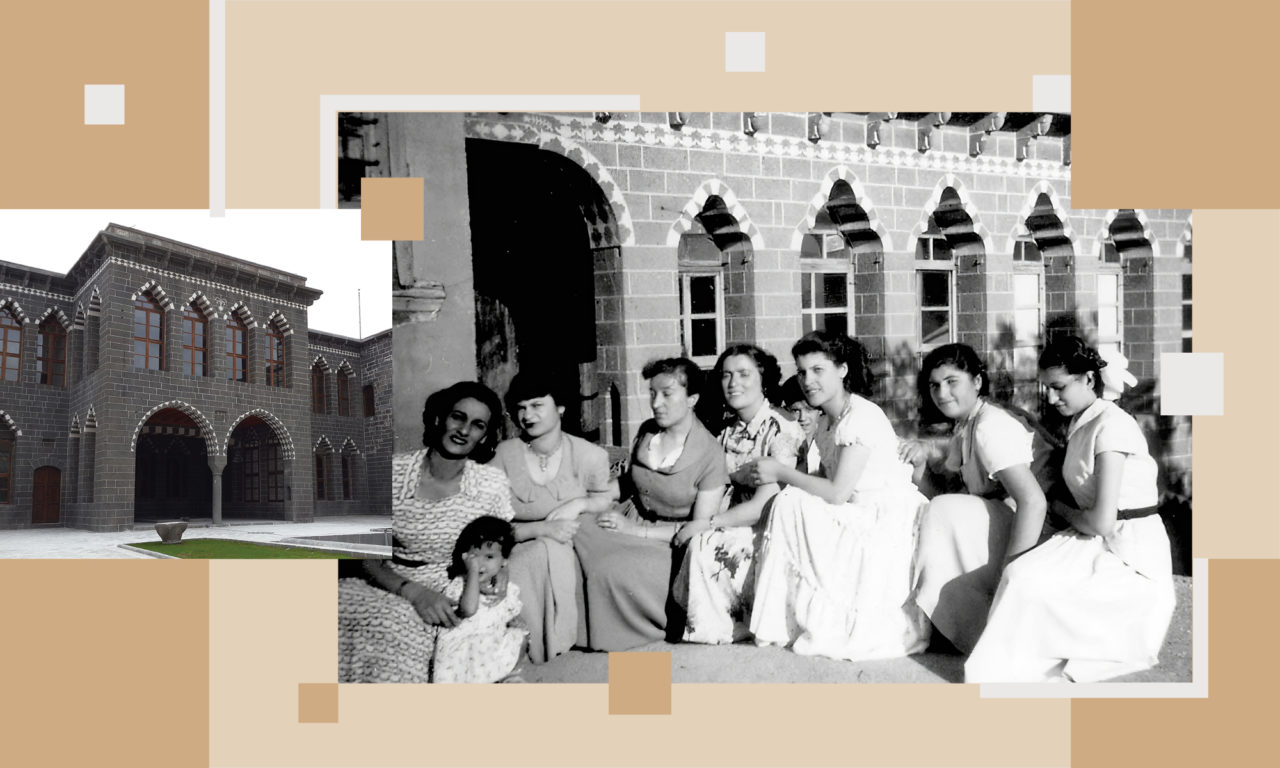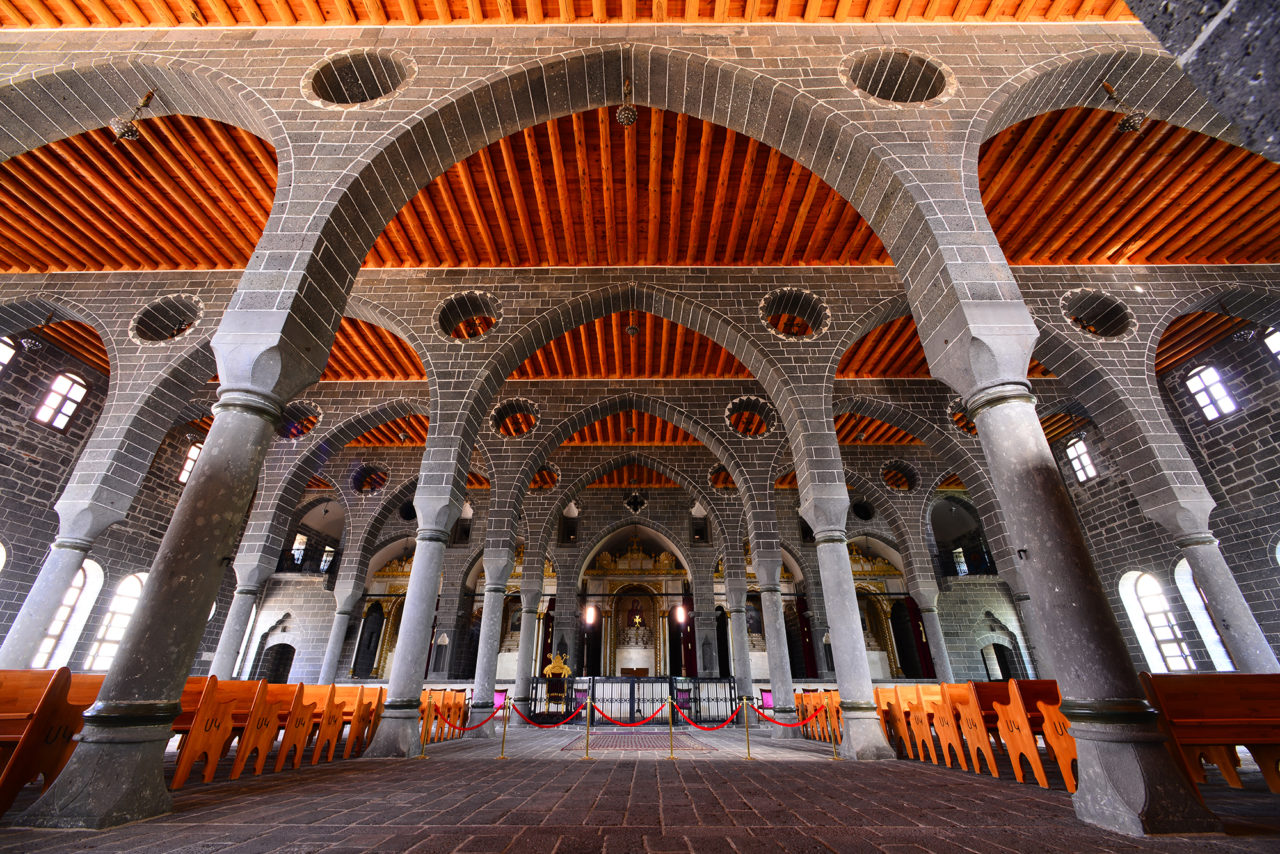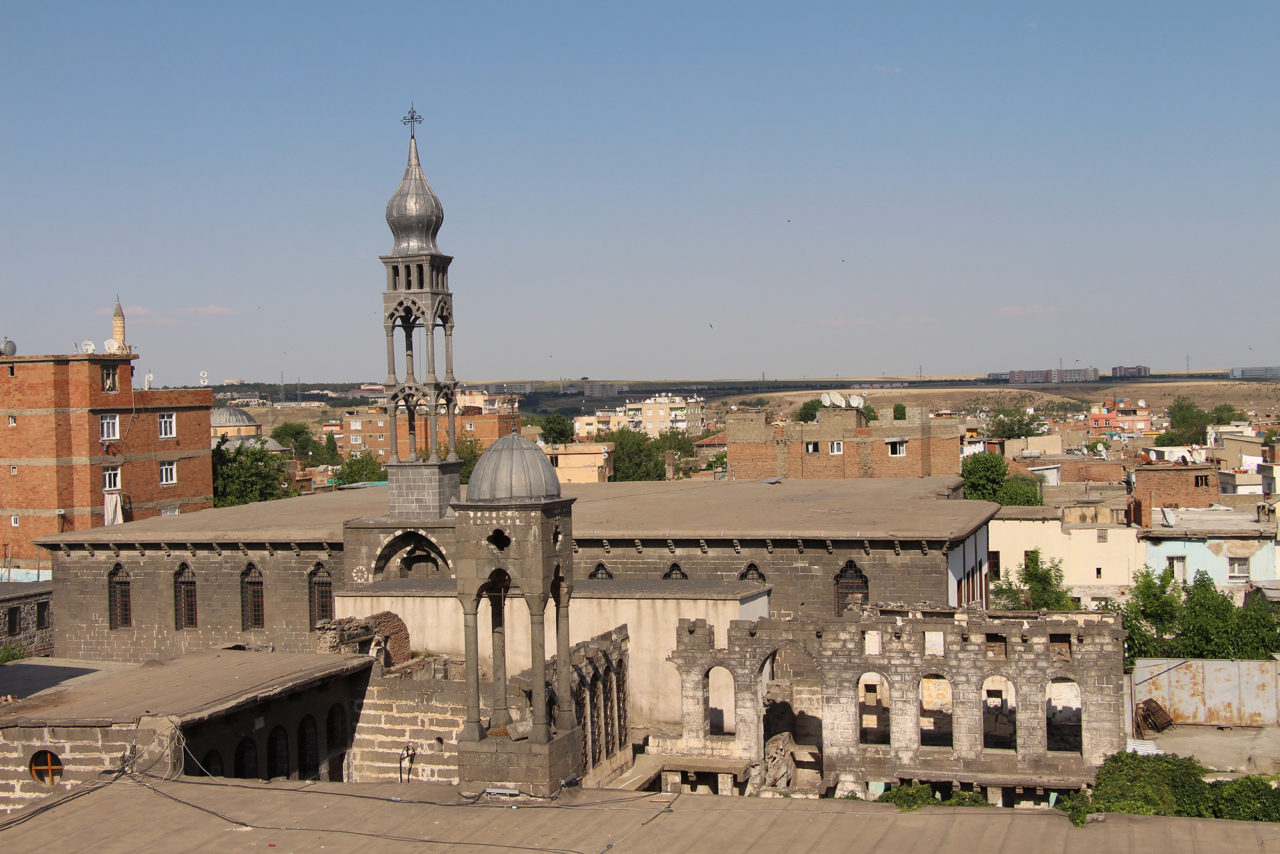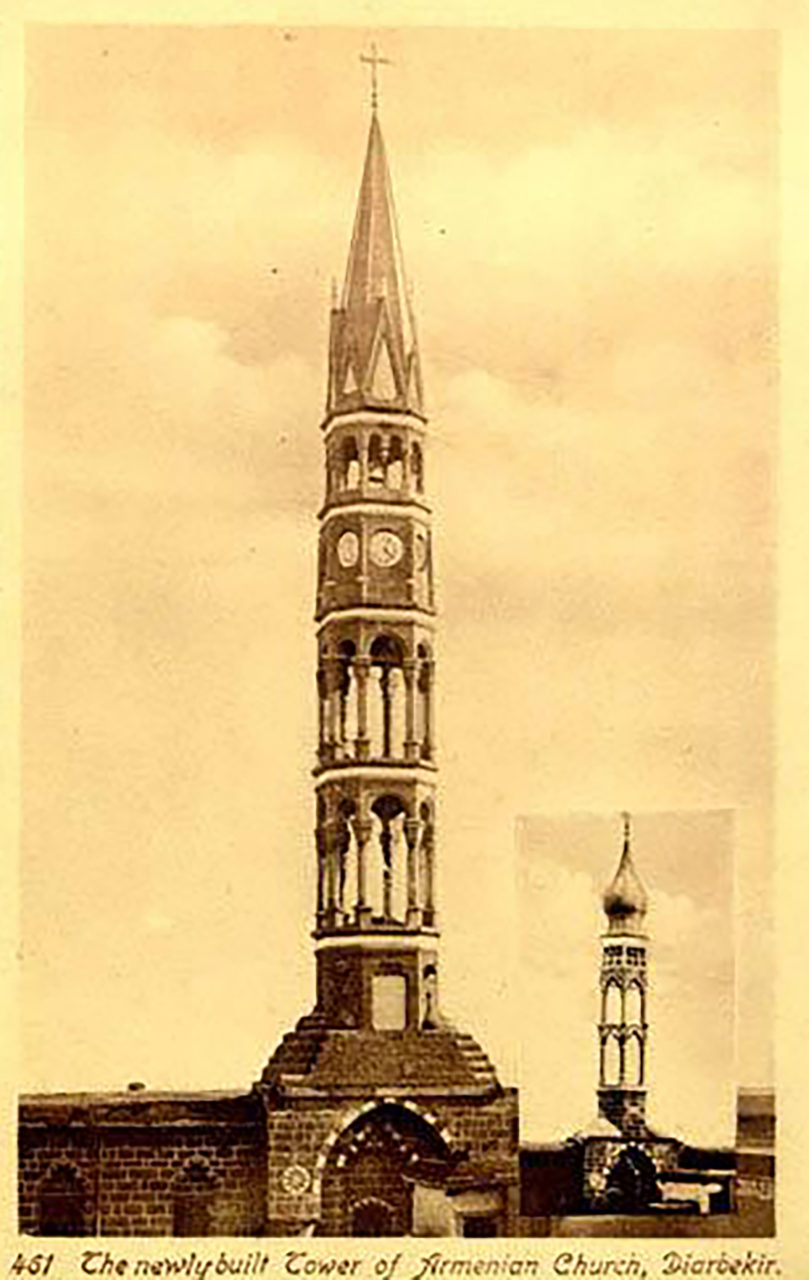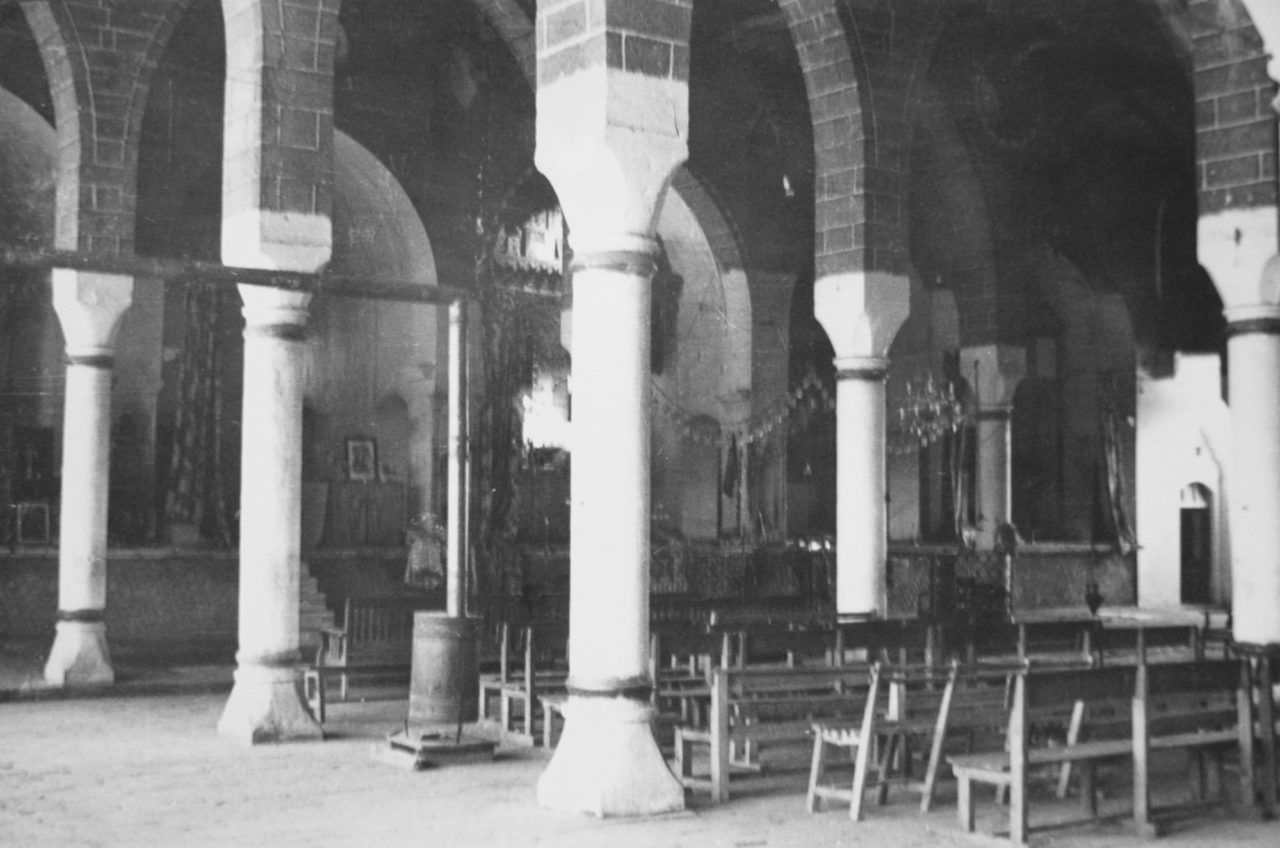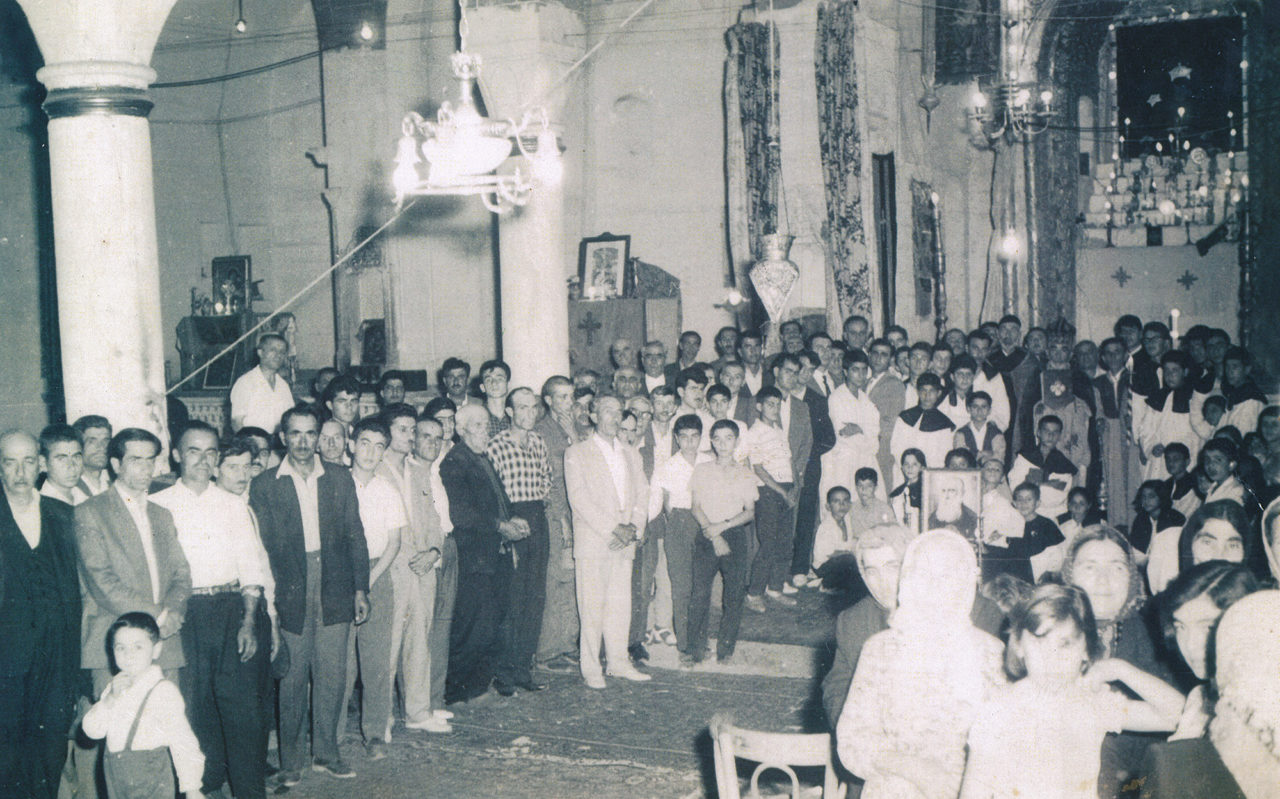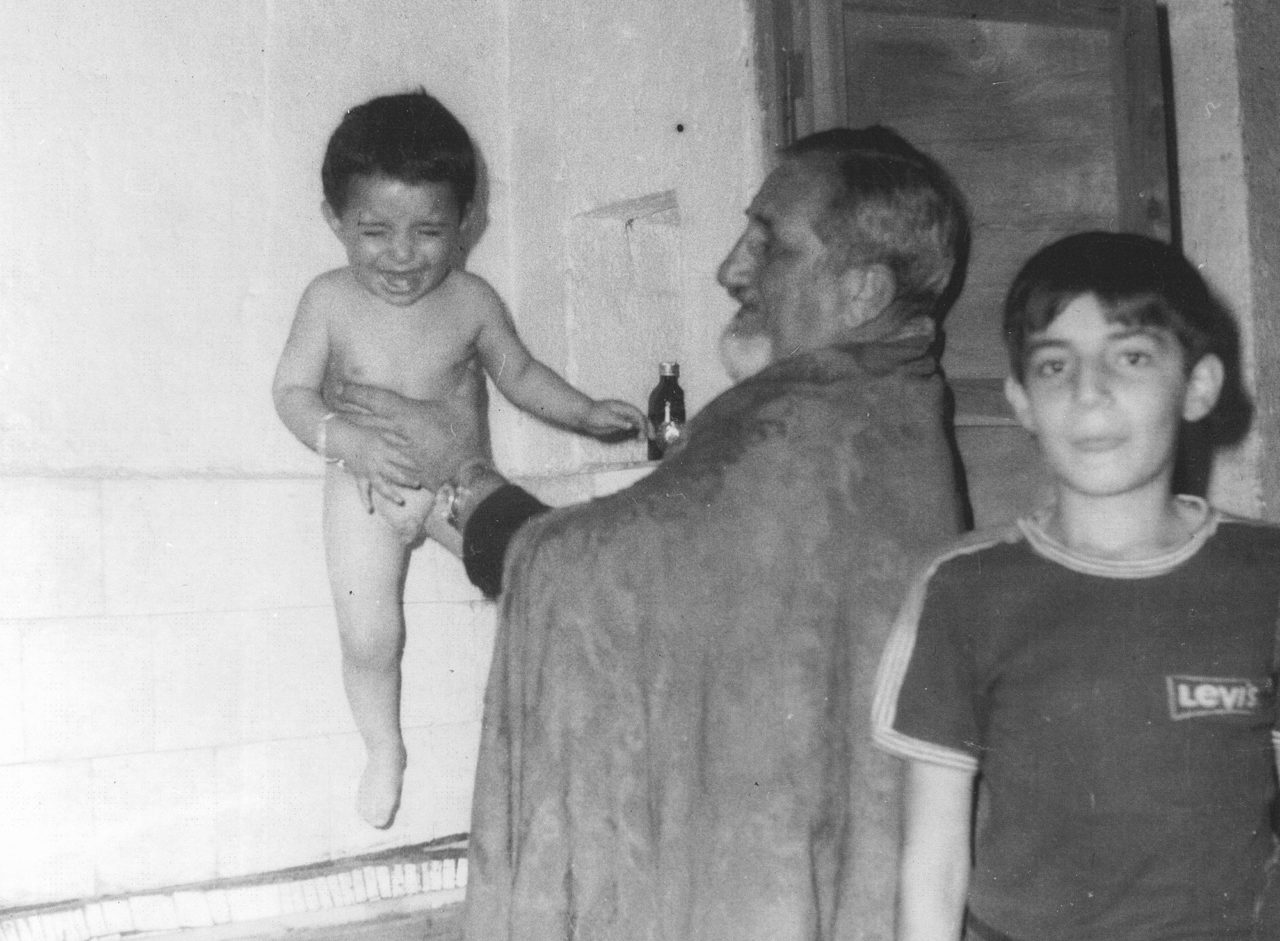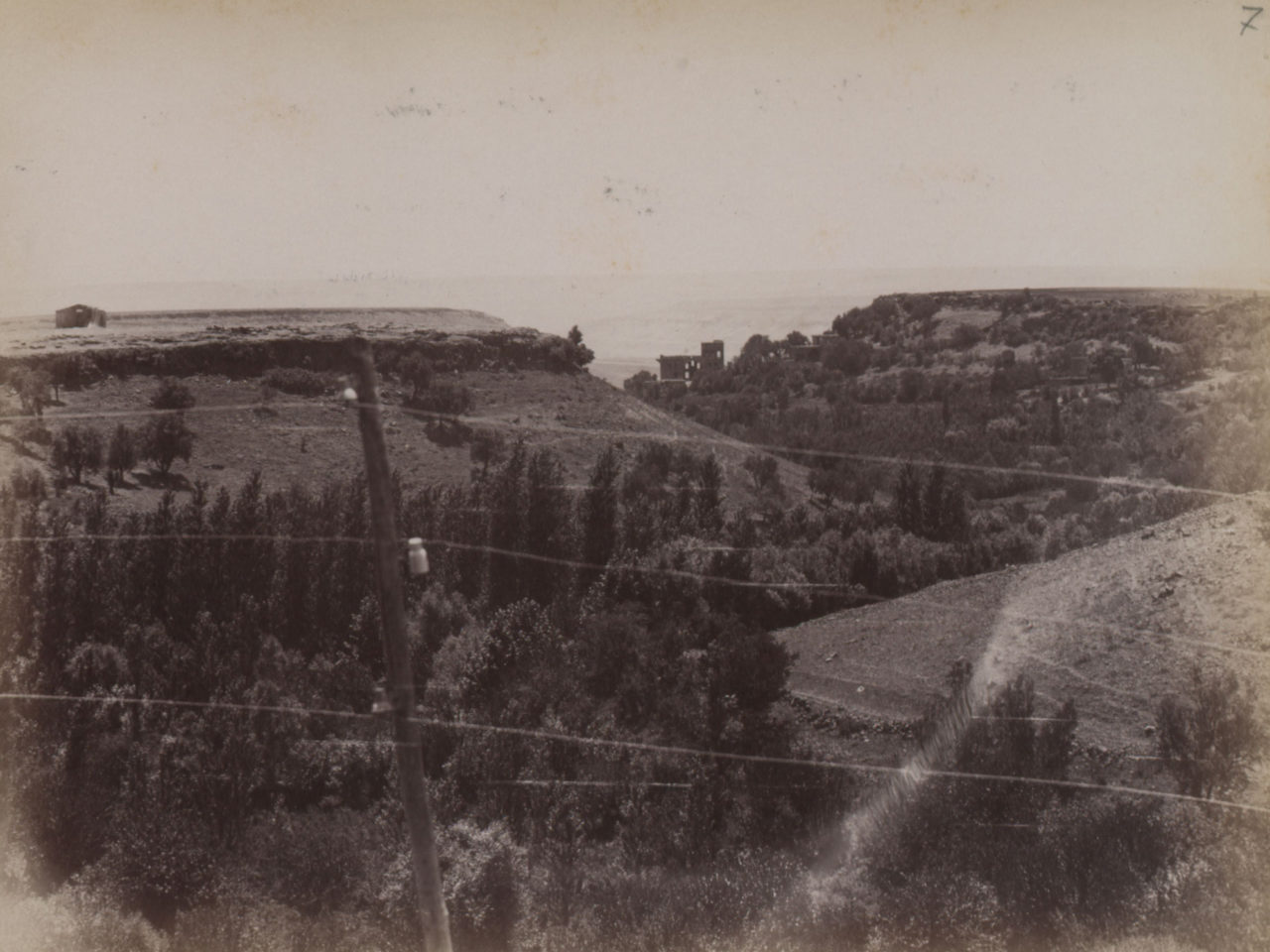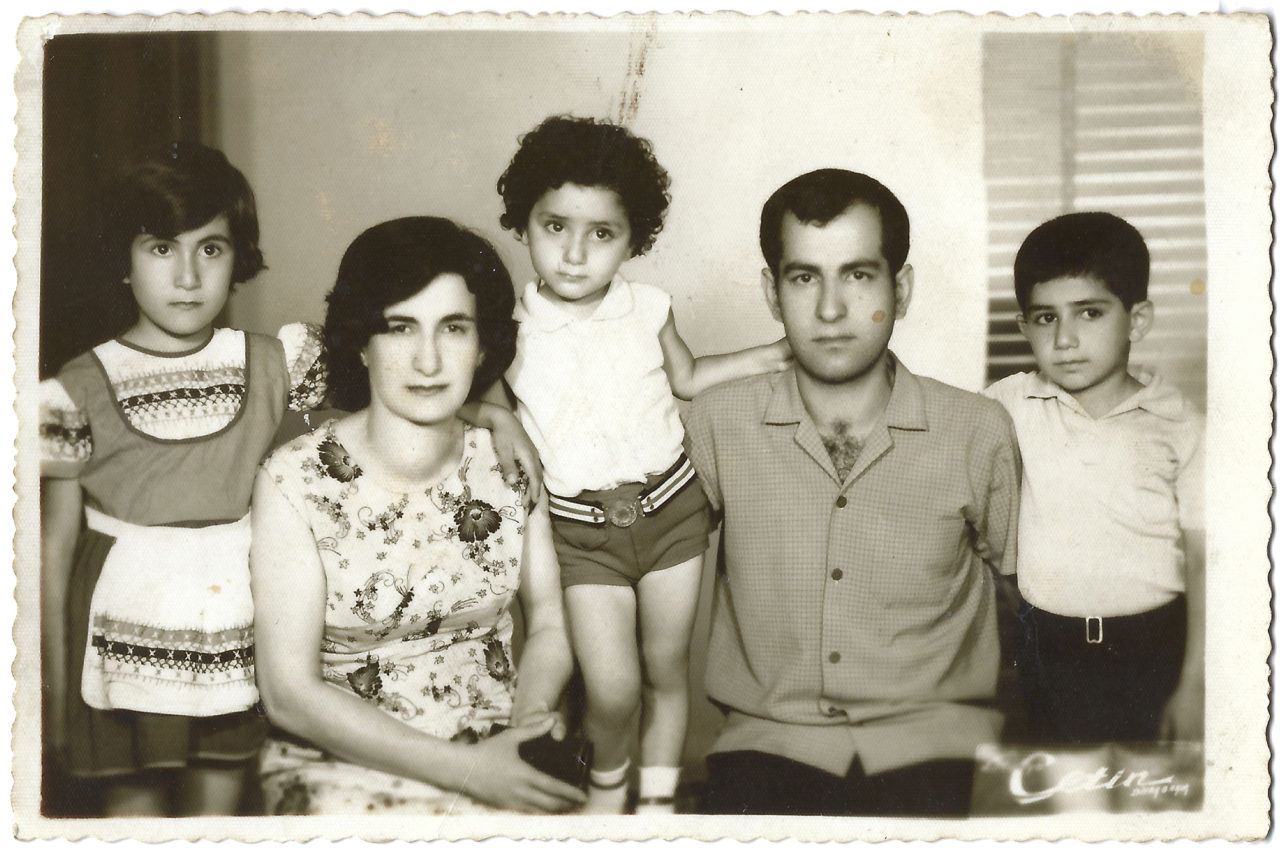Surp Giragos Church, the largest extant Armenian Orthodox Church in Diyarbakır, underwent a comprehensive restoration process from 2010 to 2014. The church was heavily damaged in the period of clashes in the city in 2015. Both its walls and roof were damaged by firearms; and the failure to intervene immediately increased the damage. Later, demolition work carried out to extend Yenikapı Street, which a façade of the church faces, destroyed all the officially registered shops that belonged to the church. In 2018, restoration work began anew.
In this section, Meral Halifeoğlu writes about the architectural history and significance of Surp Giragos Church. Then, Armenian writer Jaklin Çelik, departing from her mother Mari Çelik’s memoirs, tells the story of the Diyarbakır they left in 1970, the Armenian community’s relationship with the city, and Surp Giragos Church. Çelik’s words keeps a record of the details of the everyday life of a bygone period.
The Surp Giragos Church is in the Diyarbakır city centre, in the north-eastern section of Suriçi, or inner city area. It is the largest extant Armenian Orthodox Church in Diyarbakır. The church neighbours, to the west, the Chaldean Mar Petyum Church. Although its construction date is not known, sources refer to it as a 16th century monument. For instance, Simeon Tbir Lehatzi’s (1584-1636) travel book, refers to the church towards the end. Historian G. Indjidjian (1758-1833), in the ‘Asia’ section of his work titled “Geography”, states that this building was constructed on the grounds of the church cemetery, after the Saint Theodore Church was converted into a mosque in 1515 or 1518.
Associate Professor Meral Halifeoğlu, Restoration architect
Until 1960, the building was used for various purposes such as military warehouse, and later, a fabric depot of Sümerbank. Then, the Diyarbakır Armenian community took over the church, carried out partial repairs and returned the church to its true identity. It is also known that the church was used as a headquarters by German military officers during World War I. The magnificent bell tower of the church, built in 1914, was demolished two years later, on the pretext that it was taller than the Four-Legged Minaret of Sheikh Mutahhar Mosque…
Meral Halifeoğlu
(Photograph: Meral Halifeoğlu)
Surp Giragos Church is the largest extant Armenian Orthodox Church in Diyarbakır and at the same time, is the only example of a church with seven apses and five horizontal and vertical naves. The structure was partially used until the 1990s, and in addition to the church, with units including a chapel, a clergy house, a guesthouse, a classroom, shops and other service units, the forms an integrated complex. The church section is formed of five naves on sixteen cylindrical columns held with dual-centre vaults. The columns of the women’s or choir floor in the West, and the stone staircase ascending to this level remain; however, the upper covering collapsed completely in the 1990s. On the north and south of the apse (horan), there are rooms on the upper floor that turn into iwans. On the upper floor, there is a narrow corridor that connects the rooms that relieves the weight on the seven apses, and the iwans in the north and south.
Meral Halifeoğlu
The church has a total of five entrances, one each in the south and north, and three in the west. The lower part of the bell tower remains today, and is organized on the western façade, covering all levels of the structure. The balcony is placed within the vault upon the cylindrical pillars. The basalt balcony of the sexton displays fine details of the art of architecture.
The bell towers of Surp Giragos Church have not survived, and until the restoration, the chapel, clergy house, guesthouse, classroom and other service units were not being used. The iwan vaults in the east, where the now-closed entrance is, had collapsed. The building remained empty and derelict for a long time from the 1990s on, then, from 2010 to 2014, Surp Giragos underwent a comprehensive restoration implemented by the Hızır İlyas Foundation and Diyarbakır Metropolitan Municipality, and was thus reintroduced to the religious, cultural, artistic and social life of the city.
Meral Halifeoğlu
The Other Neighbourhood
1.
When she speaks about Diyarbakır, my mother’s words pour forth from a time when the breath of God had not yet abandoned them. Since 1970, when she came to Istanbul, she has constantly told the stories of the city where she was born in and where she gave birth to her children.
For the Armenians and Assyrians of Diyarbakır who came to Istanbul in 1970, the Gedikpaşa-Kumkapı area was a micro-scale version of the city they had left behind. For these people, whose ties of belonging with the lands they were born on had been severed, the past was now no different than a planet rapidly accelerating away from them. In order to overcome the fear this scattering had created, they gently celebrated days gone by, both good and bad, in order to heal each other. All they aimed for was to continue their lives in this new world without losing at least some of their traditions, and their joie de vivre. The stories they told each other were important, because they were experiencing a city they didn’t know, and from whichever lips they came, these stories clad in the voice of the past guided them. A shared past had fitted the Armenian and Assyrian majority of the two other neighbourhoods of Diyarbakır into a single neighbourhood in Istanbul. As many of them migrated abroad, this historical neighbourhood became their last stop in Istanbul.
My mother constantly tells stories ever since she has arrived from Diyarbakır. Everyone who lived there and everything that was lived there, circle around on a copper tray placed exactly above my mother’s chest. And that is precisely why time can never be tinned, because if it were to be tinned, then everything on that tray would be wiped away. My mother knows that.
Jaklin Çelik, Writer
2.
My mother is the plural form of the city she comes from, of Diyarbakır. The stories she tells multiply both her, and the stories. She tells the story of the other neighbourhood, and her neighbourhood in contrast with the other neighbourhood. She tells the stories of the Saint Mary Assyrian Church where she was baptized, and those of the Surp Giragos Armenian Church, in the other neighbourhood, where she was married, and where she had her three children baptized. She tells how churches filled up to the brim, and how people came and went between the two neighbourhoods. She tells how people pouring out of Sunday mass were welcomed at their dinner table. Although the Armenian and Assyrian neighbourhoods are other neighbourhoods of each other, they are nevertheless related, they are friends, and where hearts meet, they are khenami [in-law].
When my mother tells her stories, on Puşucu Street, where she was born, behind doors that have lost their şakşakos [door-knocker], the “chack-chack” sound of puşucus1 is heard once again. And amidst those sounds is heard the call to prayer, the placeless and timeless azan of Sami Hazinses, who steals the role of the mu’azzin at the minaret, calling the Muslim section of the neighbourhood to prayer with his “giaour” [infidel] voice.
Miro appears on one of the narrow streets. He has stumbled upon the streets of Hançepek after burying his daily earnings at a gambling den between “Arbedaş Direkhana”,2 after polishing off his misfortune, hardship, orphanhood and loneliness in this life with gambling, and blunting them all with alcohol. His steps sway in the dregs of darkness, and as the burden of Kırklar Mountain, loaded onto his shoulders by “Suzan Suzi”, weighs him down, he continues on his journey towards the burden of his mother Eğso waiting for him at home, which should then sober him up in the courtyard. It is right at that moment that the music of Garabed Khaço and Aram Dikran is heard on Radio Yerevan. Back then, the frequency of Radio Yerevan was the frequency of the heart, the frequency where all emotions are hung out, sway, grow and mature.
Jaklin Çelik
1 Puşucu: Puşu is the silk headscarf wrapped around the head or neck, and puşucu is a puşu-maker. Puşucu is also the name of a street close to the Saint Mary Ancient Assyrian Church.
2 Arbedaş Direkhana: A Diyarbakır folk song. Direkhanes, or pole workshops, where wooden poles were made and sold, were in the neighbourhood where the Arbedaş water source was.
3.
And when the words of stories begin to prickle inside, the photographs come out. In black and white images, beaming smiles pour forth, as if they are never going to abandon the place they are in. It is almost as if they have just left a dinner table, to return promptly. When poppy gardens bloom in Hevsel, the arrival of spring is celebrated at the Gazi Mansion. In a family photo, wearing winter clothes on a winter day, family members strip, and the season turns to summer. Steps head from Melik Ahmet to the Four-Legged Minaret, and from there, to Hançepek.
And at the Dilan Movie Theatre my mother meets Greta Garbo, Rita Hayworth, Rock Hudson, Vivien Leigh and Clark Gable. As for Princess Soraya and Jacqueline Onassis, she got to know them in the pages of Hayat magazine. This is why, when it comes to menswear, her references and icons are Humphrey Bogart and Clark Gable; and when it comes to women, she reflects the style of Rita Hayworth and Princess Soraya. In my mother’s mind, the Dilan Movie Theatre is a bitter taste that has “gone with the wind”… And that is how she tells its story.
She tells us how she went to the Dilan Movie Theatre with her cousins Abdo and Süslü, wearing the shoes her elder brother had bought her. Back then, with his dark grey coat, sunglasses and polished shoes, Abdo is a living reflection of the images on the postcards of American actors she used to collect back then. She burned the postcards after her sister Süslü passed away at eighteen years of age. Not long after, Abdo died at twenty. So Mari burned the books she had brought for Abdo to read, the books which she collected behind the wine barrel in the cellar. In that fire burned Madame Bovary, Anna Karenina, Michel Zévaco and all the others.
Jaklin Çelik
4.
My mother has always been telling stories, stories of events and people, what time swallowed and what got stuck in time’s gizzard, the good and the bad, for fifty years… She tells the story of the Bible stolen from Kırklar Mountain. As the thieves escaped via the Tigris, the raft they were on stopped, motionless, opposite Kırklar Mountain. Suddenly, a woman appeared, in her birthday suit, bathing on the shore of the Tigris. The thieves then realized that the raft would not move if they did not take the stolen Bible back to the church on Kırklar Mountain. Once they put back the Bible where they had taken it from, the raft moved, and the woman bathing on the waterside disappeared into invisibility. We used to listen to this story and the like, which began with the words “Once upon a time…”, in the garden floor of our home in Kumkapı when the power went out. In the garden’s darkness, the Tigris warbled, and on the walls, the shadows of the city afar danced.
Jaklin Çelik
5.
Neither a tear drop nor heavy reproach accompany my mother’s stories. After all, one cannot cry to one’s own story. If you cry, that’s someone else’s story. At times, a deep sigh. When she saw a photograph of the rice mill factory at the entrance of the Hevsel Gardens, once ran by her father, she said, with that same deep sigh, “There is no doubt that a drop of sweat from my father’s brow has fallen into the Tigris”. No one knows, not even my mother, that every time spring arrives anew, a leaf on its branch cries in the Hevsel Gardens.
However, after she had come to Istanbul, she has never wanted to go back to Diyarbakır. She has a good reason: “My heart is broken,” she says, when asked. After all, one can have several reasons not to go back to the city one was born and grew up in. She may be offended, the city may have hurt her, broken her story in two right through the middle, at the worst time.
Radio Yerevan is a legend in the region, although its time has now passed. Yet these days, children still grow up with the music of Garabed Khaço and Aram Dikran in the streets of Diyarbakır. And as those children grow up, humanity grows, and hope grows.
And I know well, my mother, too, wants it that way…
Jaklin Çelik
Translation: Nazım Dikbaş
BIBLIOGRAPHY
Meral Halifeoğlu
• van Berchem, M. (1910) Amida: Matériaux pour l’Epigraphie et l’Histoire Musulmanes du Diyar-Bekr, Carl Winter’s Universitätsbuchhandlung, Heidelberg.
• Halifeoğlu, F. M. (2012) “Diyarbakır Surp Giragos Kilisesi Üzerine Bir Değerlendirme”, Kâgir Yapılarda Koruma ve Onarım Semineri IV, KUDEB, Istanbul: 25-36.
• Halifeoğlu, F. M., Güler, M. Ş., and Kıran, B. (2012) Surp Giragos Kilisesi’nin Restorasyon Projesi.
• The personal archive of Tomas Çerme.
• Tuncer, O. C. (2002) Diyarbakır Kiliseleri, Diyarbakır Büyükşehir Belediyesi Kültür ve Sanat Yayınları, Ankara.
